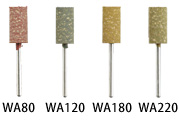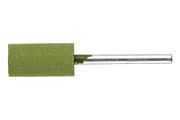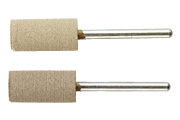- Contents
- Features and Usages of Different Material Types
The CM type has a special abrasive grain developed in-house and also an original rubber composition, which enable it to exhibit excellent cutting quality that is unique to Daiwa Rabin.
It is a long-selling type that represents "Daiwa Rabin" not only because of its unique elasticity (softness), but also because of its design that perfectly balances the cutting quality, polished surface, and durability, and its use in various operations involving different types of materials.

- It can remove the processing marks left from direct end-mill carving of metal forging dies, as well as cutting marks on FCD 600 class, SUS, and heat resistant alloys. Processes like heat treatment, carburizing, and nitriding are also not difficult to perform even with high hardness (HRC60 level).
- Due to its unique elasticity, it can be aligned with the work piece, which prevents jumping and chattering of the work piece caused by hitting. It can thus be used with ease and can also lessen the workload.
- As a result of the cutting quality and rubber elasticity, the stubborn aluminum and mold wash adhering on to the aluminum die cast molds can be removed without causing scratches on the surface of the mold, or being concerned about surface roughness or over-cutting, and therefore, hassle-free maintenance task can be performed.
- Surface polishing of aluminum die cast products (removing wrinkles and bubbles from the casting surface, sink marks, pinhole correction, and parting line), removal of cutting marks from aluminum and other soft metals, and removal of processing marks from aluminum mass-production products can be performed without worrying about clogging, thus improving the mass-production effect.
* This clog resistance property proves to be very effective during automation at the time of machining and on the CNC lathe. - For plated products, the material can be finely adjusted to prevent scratches, and the best suited surface finish can be selected for the plating.
Resolving surface roughness: For your "polishing" work, you may use the OX type that offers a wide range of grain sizes.
Although this type is used mainly for polishing, from the viewpoint of work piece material having high hardness and different surface conditions, and also in view of durability even in the case of the polishing process, a reasonably tough rubber design has been adopted.

- It can also be used for edge honing of carbide cutting tools, and removal of fine burrs from various materials.
- It is also used widely for removing burn marks, scales, rust, scratches, dents, and chuck marks from resin dies, and depositions on the surface of press and forming dies, and also with electrodes of copper, tungsten, and SUS, and in other maintenance tasks.
- It is also used for removing paint, plating, and coating, as well as tarnish from the glass surface through the adjustment of the rubber material such that the backing is not damaged, and thus scratches can be prevented from occurring.
*As a special use, this type has been used for long in the hairline processing of clock parts and SUS thin boards in home appliances for improving the yield and providing stable and continuous processing.
For the de-burring process, the rubber is hardened to prevent the burrs and edges from eating into the rubber.

- From the viewpoint of the shape, the design helps control deformation of the rubber, and continuous processing can be performed while maintaining the shape of the stone and preventing damage to the shape of the work piece.
- We provide products that can simultaneously perform de-burring and lap polishing on fine burrs formed on parts possessing important functions in precision components.
- Because of excellent durability of Daiwa Rabin and a design that proves to be strong against burrs, it is also used in the de-burring process at the time of machining and on the CNC lathe.
Diamond Rabin is the result of an ideal combination of excellent rubber features of Daiwa Rabin and a diamond abrasive grain, which offers much greater performance and improves the processing as a new diamond tool that was not seen until now.
While "high-speed grinding" and "high-speed milling" have evolved remarkably as processing methods for improving the product quality and increasing the mass production performance, it is necessary to simultaneously increase the rigidity and precision (…. increase in cost) of tools and usage equipment, select tools and manage their status, and seek refinement in truing and dressing processes, as well as the drive programs. There are also inevitable problems such as heat generation, and other problems of processing damage, and occurrence of burrs due to difficulty in processing as a result of a minute size.
The grinding and polishing processes that make use of rubber elasticity have opened the path to an approach that is different from the high-speed technique, and have greatly reduced the problems and the cost factor accompanying high speed, which has made the superiority of Diamond Rabin stand out.
"Rubber elasticity" is a feature of this tool
- There is no need to take measures against the large amount of heat generated during high-speed grinding and cutting.
- The residual stress and heat damage are reduced to a great extent, and as a result, micro-cracks can be prevented.
- Because Diamond Rabin exhibits excellent cutting quality even at medium and low speeds, there isn't too much need for high rigidity and high precision of devices and tools used for high-speed rotation, which reduces the special additional cost for metal cutting machine tools.
- The excellent durability that Daiwa Rabin possesses is further improved thus increasing the life as compared to other tools.
- Large quantities of grinding fluid are not needed, and in some cases, semi-dry or dry processing is also possible.
- The grinding and cutting mechanism of a rubber stone is different from that of a grinding wheel and cutting tools, and ductile breaking may be expected to be a failure mode. An improvement in the surface finish is naturally expected, but at the same time, the concern over scratches from the polishing powder are also reduced. The cost involved can be reduced through the stability of quality and improvement in the yield.
- A dedicated dresser is not needed for truing or dressing. The dressing interval is also long, which reduces the cost of tool management.
- *Diamond Rabin is also opening the path to automatic mirror polishing of aspherical areas as well as automation of mirror polishing of plastic molds, which has long been sought after, only by mounting a holder having a low-pressure and an eccentric mechanism on to the present unit.
⇒New Generation Processing System
"Senrap", in which cerium oxide is blended into rubber, has enabled continuous polishing over very long periods to give a glass mirror finishing only with the use of water.

- It enables the shift from the free abrasive grain method to the fixed abrasive grain method, reduces various costs involved in the use of large amounts of cerium, management of tools to check wearing of pads and deviations, management of the water temperature, and difficult tasks of disposal and equipment maintenance, and exhibits a high cost performance matching high-cost tools with outstanding durability and stable processing quality.
When considering the ideal process for mirror polishing of glass, the processing state of the work piece prior to the final polishing is also important.
By combining together a general diamond tool and Diamond Rabin developed by Daiwa Kasei, the surface condition can be improved,
and the workload of final polishing with Senrap is reduced. To examine the problem of final polishing, pre-processing must also be taken into consideration.
We offer customized designing in accordance with your equipment and the size and shape of the polishing area. Feel free to contact us in this regard.
Another interesting point is that non-suitability to ferrous materials is rarely seen because of which a CbN wheel is not needed.
These features can be expected when the ideal grinding stone material is selected and the usage conditions are set in accordance with the work piece.
The amount of efforts needed for the process can also be reduced to a large extent.





